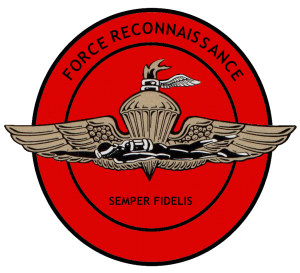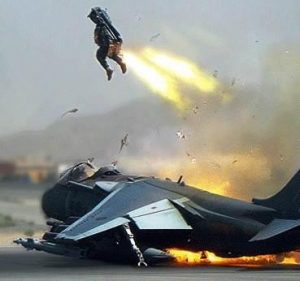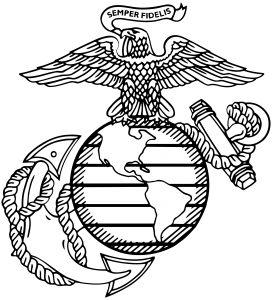Steve the Harrier Pilot – Short Story of the Month
Alaska, Bush Pilots, and Volcanic Ash – January 27, 2012
January 27, 2012Aviation Wisdom from the Past – February 20, 2012
February 19, 2012Life of an Aviator
(Short stories by Robert Novell – Volume Two)
Part One
(My first encounter with Steve)
Steve was a unique individual and a man of many talents; however, he had a problem. It was Steve’s way, Steve’s way and Steve’s way. For a person who spent ten years in the Marine Corp this was most unusual. Steve, whose nickname was no-neck because his head seemed to sit on top of his shoulders without a distinction between the two. Steve joined the Marine Corp out of High School and his first four years were spent as a member of what the Marine Corp calls Force Reconnaissance, Force Recon for short, and then he transitioned in to aviation as a Harrier pilot.
My first meeting with Steve was in Lima, Peru where he was flying as a support pilot for a program the US Embassy had in place to help the Peruvians fight the drug cartel and the rebel forces pretending to be freedom fighters. I was in Peru to deliver an airplane from the U.S., for the broker who had sold it, and was waiting for word from the broker that all was well for my return. I was in the hotel bar having coffee, and cognac, after dinner when I could not help but over hear a guy telling war stories about his time flying the Harrier. The guy was obviously from the U.S. but his demeanor as a former Marine surprised me. Normally Marines are usually a little more low-key, based on their training, and since I too was a former Marine, I was a bit curious as to whether he was what he said he was.
As the patrons of the bar thinned out, or moved away, Steve started surveying the bar to see whom else he could dazzle with his stories, and he saw me sitting alone at a corner table enjoying my quiet time. “Hey, are you from the U.S?” Steve shouted across the room and I responded by saying nothing but I did nod my head yes. Well, that was all he needed to know, or see, and the next thing I knew Steve was at my table, uninvited by the way, telling me all about the Harrier and his exploits as a US Marine.
Not exactly, what I had in mind but…………….
Steve immediately wanted to know what I was doing in Peru but I opted not to tell him I was a pilot. I told him I was there on business with a marketing firm from the U.S. who were trying to get an exclusive agreement on a line of winter garments made from Alpaca; however, after saying that I immediately asked if he was a Jarhead. For those unfamiliar with the term Jarhead, this term is used by Marines, amongst themselves, and is not derogatory but can be when used by outsiders. Sailor’s on-board ships originally used the term during WWII, in an effort to insult the Marines – it did not work. So, usually when you ask a guy if he is/was a Jarhead the first thing they will say is, “Were you in the Corp?” This was precisely what Steve asked me and of course, I gave him a brief history of my involvement with the Corp, in the late 60s, early 70s, and this was all that Steve needed to hear and he immediately began to tell me about his Force Recon days.
Part Two
(A little history about Marine Force Recon)
The mission of Force RECON is to conduct amphibious reconnaissance, deep ground reconnaissance, surveillance, battle space shaping, and limited scale raids in support of the Marine Expeditionary Force (MEF), other Marine air-ground task forces, or a joint force.
US Marine Reconnaissance units are tasked with providing the commander of a larger force of Marines with information about his operational area. Their missions usually focus on specific information requirements, which, due to their changing or unique nature, cannot be obtained by means other than putting a man on the ground to observe and report. Recon Marines are, by nature, capable of independent action in support of the larger unit’s mission.
The history of Recon Marines begins in World War II, when two units were formed: the Raider Battalion, which was created in January 1942 with the intention of providing the Marines a light-force raid unit much like the British Royal Marine Commandos, and the “Observation Group” of the 1st Marine Division, comprised of two officers and twenty enlisted men. The latter was expanded to 98 Marines in 1943: renamed the Amphibious Recon Company, and served on the island of Apamama in the Pacific. Their success in aiding the invasion led to another expansion to 20 officers, 270 enlisted, and 13 Navy doctors. The Observation Group participated in landings for the rest of the war, including Tinian Island, Iwo Jima, and Okinawa.
The need for recon became prominent once again in the Korean War, where the Amphibious Recon Company was called upon to make landings in Northern Korea and report back their findings, and carry out raids against tunnels and rail lines, with some of these missions taking place as much as 40 miles inside enemy territory. Recon members also operated closely with US Navy Underwater Demolition Teams during some of their missions. In March of 1951 the force was expanded and named the 1st Amphibious Recon Platoon, and would continue to serve after the end of the war. In 1957, the 1st Company of “Force” Recon Marines was formed, and 2nd Company Force Recon was formed in June 1958. In 2006, as part of reorganization under MARSOC, both companies were deactivated, and force reconnaissance is currently carried out by the 1st and 2nd Reconnaissance Battalions, under the 1st and 2nd Marine Divisions, respectively.
The 1st Reconnaissance Battalion was reactivated in June 2000 but the battalion was originally activated in March 1937, and was primarily a scout/sniper unit. In April 1944, a two-company amphibious reconnaissance battalion was formed with the mission of conducting beach reconnaissance and hydrographic survey. Today the Battalion performs a wide variety of tactical and special operations in support of the Division.
THE RECON CREED
Realizing it is my choice and my choice alone to be a Reconnaissance Marine, I accept all challenges involved with this profession.
Forever shall I strive to maintain the tremendous reputation of those who went before me.
Exceeding beyond the limitations set down by others shall be my goal.
Sacrificing personal comforts and dedicating myself to the completion of the reconnaissance mission shall be my life.
Physical fitness, mental attitude, and high ethics -The title of Recon Marine is my honor.
Conquering all obstacles, both large and small, I shall never quit.
To quit, to surrender, or to give up is to fail.
To be a Recon Marine is to surpass failure; to overcome, to adapt, and to do whatever it takes to complete the mission.
On the battlefield, as in all areas of life, I shall stand tall above the competition.
Through professional pride, integrity, and teamwork, I shall be the example for all Marines to emulate.
Never shall I forget the principles I accepted to become a Recon Marine.
Honor, Perseverance, Spirit and Heart.
A Recon Marine can speak without saying a word and achieve what others can only imagine.
Steve was indeed the real thing and I know this from friends who went the Force Recon route. He spoke of being inserted deep in to Viet-Cong territory and staying for ten days until they were extracted. He spoke of his unit missing the deadline on their extraction time and had to reposition to a location two days away to meet their extraction helicopter at the next scheduled pick-up point, and he told me about how everything they took with them had to come out – no evidence could be left behind of their presence. Yes, he had done what very few could. However, how did he end up in Harriers?
Part Three
(From Recon, to the Academy, and then off to Marine Corp. Flight School)
After Vietnam Steve was given the opportunity to go to college by participating in a program called the “Boot Strap Program.” What they would do was send him to a one-year prep school, and if he was successful, then he would be given an appointment to the Naval Academy. Steve, being a smart guy in addition to gutsy, breezed through the prep school, and graduated from the Academy with honors, although he had a few personality conflicts with the school’s leadership and their policies.
Steve was then sent to flight school in Pensacola, Florida, where he learned to fly jets, and was assigned to an A-4 squadron at Cherry Point, North Carolina. Then one day they asked for volunteers for the Harrier program. Steve being Steve, he said “Hell yea I will do that – sign me up.”
I am not sure of all the specifics of his training in the Harrier; however, I do know that after Steve went to an active squadron he excelled at his craft and was soon doing demonstration flights for the Marine Corp at other military bases. This is when his charmed life took a “U” turn.
The Harrier pilots would always conclude their performance at an airshow by hovering stationary in front of the crowd, at some specified distance away, and then the pilots would augment the thrust in a way that the nose of the airplane would pitch down as though it was bowing to the audience. Steve was performing this maneuver when somehow the Velcro strap around the sleeve of his flight suit snagged on a lever that created a thrust vector that sent the airplane out of control. Steve knew he had lost control at too low an altitude to recover, he ejected from the airplane, the airplane hit the ground, burst in to flames, and was destroyed.
Steve had ejected at almost ground level and although the ejection seat should have rocketed him to a safe altitude for his parachute to deploy it did not. Steve came back down to the ground and hit hard, with only fifty percent of his chute open, and was severely injured. I think it was almost two years before Steve was able to return to flight status but it was not in the Harrier. They had moved Steve in to the Hercules transport aircraft and he spent the rest of his career trying to live down the mishap.
Steve opted to retire early and move in to commercial aviation and it was roughly five years after that when I met him in Lima. I have run across Steve a few times, as I move around the world on different contracts, but regardless of where I go there always seems to be someone who knows Steve and has a Steve story. So, let me tell you a few of my favorite Steve stories, which are second-hand, but based on my knowledge of Steve’s personality I would say they are mostly true.
Favorite Steve Story Number One
This story takes place in Sudan where Steve was working a contract in support of a US Embassy project. Steve was taxing out for departure one morning and was running late. As luck would have it, he was behind two larger airplanes taxing out who were moving far too slowly for him so in typical Steve fashion he went in to the grass, sped by the two larger airplanes, re-entered the taxiway, and called ready for take-off. I think you can guess what happened next.
Favorite Steve Story Number Two
The country this time was somewhere in the bulge of Africa and Steve was denied clearance for take-off because of money due. Steve argued with the controllers telling them that all fees were paid in cash, but they demanded that he taxi back and speak with the appropriate authorities. Steve’s response was to taxi the airplane to the base of the control tower, shut down the airplane, and climbed the steps to the door of the tower and began to yell and scream until the local military officials showed up and escorted him back to his airplane. The local authorities then called the company he was working for, and demanded that he leave their country and never return. Steve left the next morning. I can almost hear Steve saying, “Those bastards are not going to get by with this. I am a Marine Recon survivor and a retired Marine Corp aviator, and I will not bow to some third world air traffic controller who wants to steal more money. Damn him – I will show him why he picked the wrong person to play games with.”
Favorite Steve Story Number Three
This time Steve was in the Philippines working after Mount Pinatubo erupted. I am not sure who was on the airplane but someone said, “Can we get a closer look at Mount Pinatubo – we want some pictures.” They got some good close up pictures but Steve should have stayed a little farther away from exposed crater and ash cloud. A complaint was filed and once again Steve was asked to leave the country.
There are many more Steve stories but the three mentioned personify my friend Steve. I never heard anyone say anything bad about his skills as a pilot but the stories about his quick temper and spirit of adventure abound. It has been some time since I have heard from Steve, or heard a new Steve story, so I think he finally gave up on working internationally and moved back home to North Carolina. I suspect he has probably bought himself an airplane and is dropping jumpers and then enjoying the thrill of beating the jumpers back to the drop zone.
Good luck to you Steve and relax – You have nothing to prove and remember, from one Jarhead to another, life is short. Relax, enjoy time with your wife, kids, and grandchildren.
“Semper Fi” old friend and God bless.




